Leadership in IT and Project Management: A Comparative Analysis
VerifiedAdded on 2023/04/04
|8
|2305
|457
Report
AI Summary
This report provides a critical analysis of leadership in IT and project management, focusing on two key areas: project selection methodology and activity duration estimation. The first section examines the importance of project selection and the application of the Six Sigma method, discussing its advantages, limitations, and the use of case studies. It contrasts this approach with alternative methodologies, highlighting the need for a comprehensive understanding of project selection criteria. The second section delves into estimating activity duration, evaluating the MODAPTS Plus method and comparing it with other established and automated project management tools. The report emphasizes the importance of considering various factors beyond time estimation and advocates for a well-rounded approach to project management, incorporating comparative analyses and recommendations for effective decision-making.
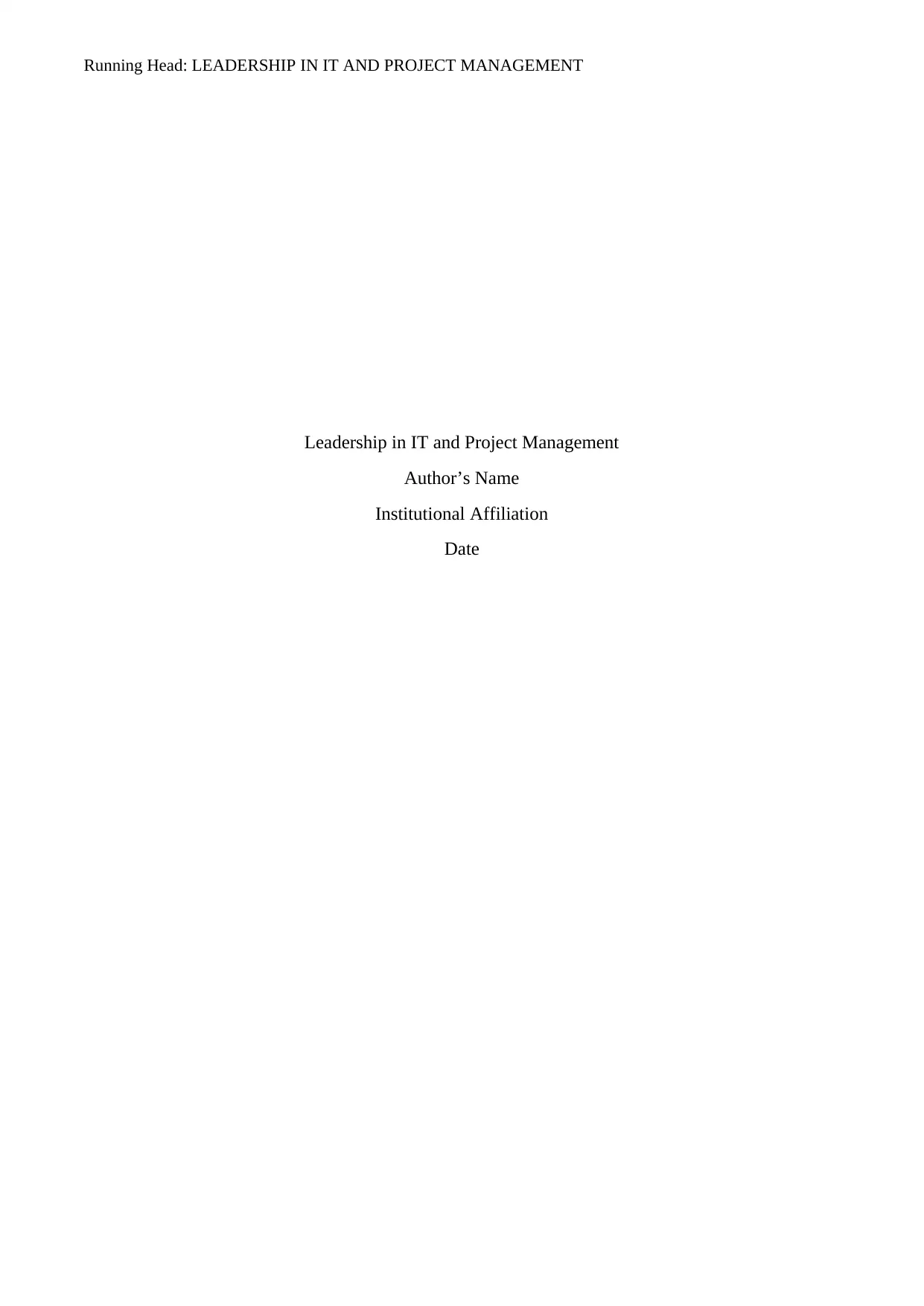
Running Head: LEADERSHIP IN IT AND PROJECT MANAGEMENT
Leadership in IT and Project Management
Author’s Name
Institutional Affiliation
Date
Leadership in IT and Project Management
Author’s Name
Institutional Affiliation
Date
Paraphrase This Document
Need a fresh take? Get an instant paraphrase of this document with our AI Paraphraser
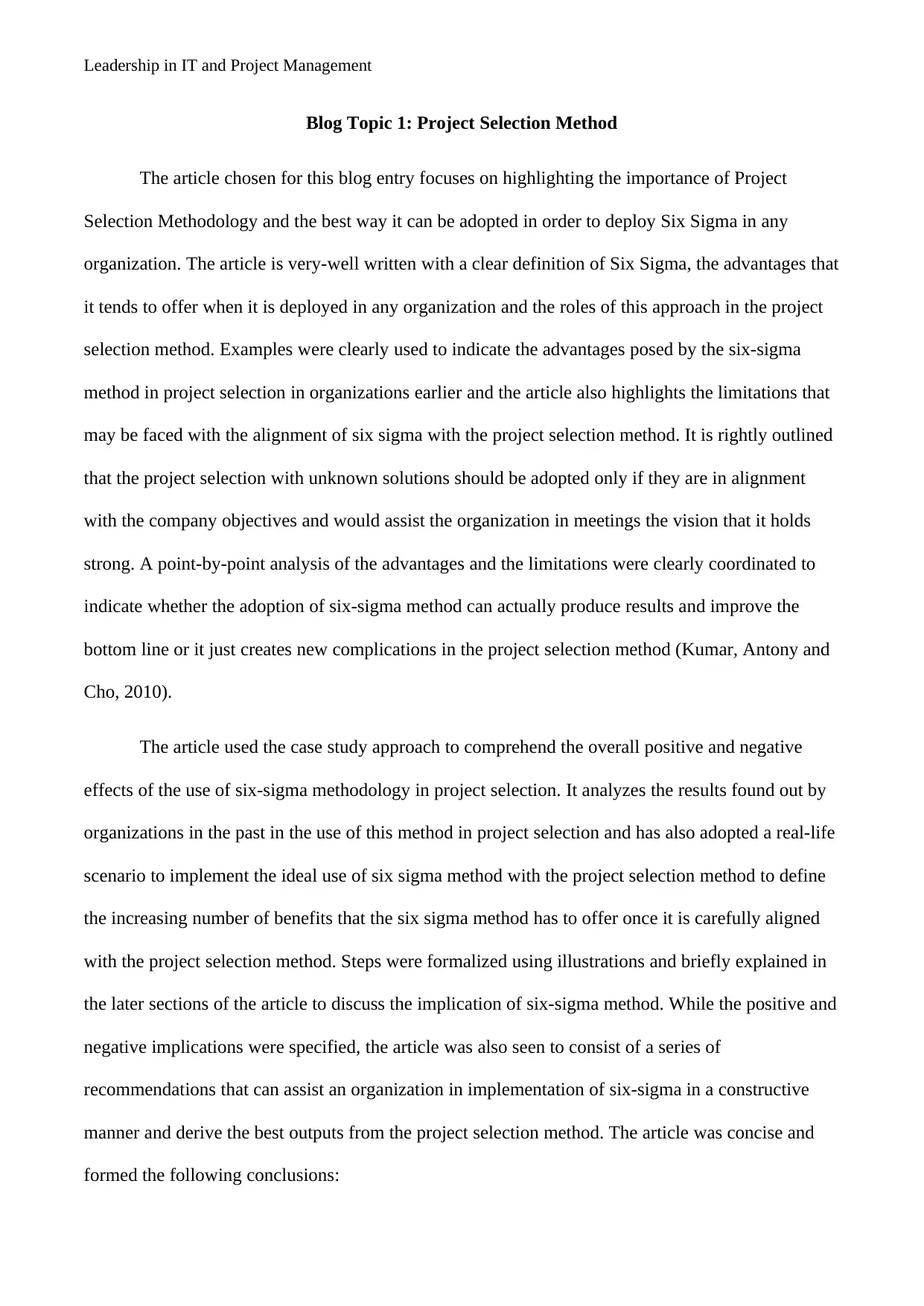
Leadership in IT and Project Management
Blog Topic 1: Project Selection Method
The article chosen for this blog entry focuses on highlighting the importance of Project
Selection Methodology and the best way it can be adopted in order to deploy Six Sigma in any
organization. The article is very-well written with a clear definition of Six Sigma, the advantages that
it tends to offer when it is deployed in any organization and the roles of this approach in the project
selection method. Examples were clearly used to indicate the advantages posed by the six-sigma
method in project selection in organizations earlier and the article also highlights the limitations that
may be faced with the alignment of six sigma with the project selection method. It is rightly outlined
that the project selection with unknown solutions should be adopted only if they are in alignment
with the company objectives and would assist the organization in meetings the vision that it holds
strong. A point-by-point analysis of the advantages and the limitations were clearly coordinated to
indicate whether the adoption of six-sigma method can actually produce results and improve the
bottom line or it just creates new complications in the project selection method (Kumar, Antony and
Cho, 2010).
The article used the case study approach to comprehend the overall positive and negative
effects of the use of six-sigma methodology in project selection. It analyzes the results found out by
organizations in the past in the use of this method in project selection and has also adopted a real-life
scenario to implement the ideal use of six sigma method with the project selection method to define
the increasing number of benefits that the six sigma method has to offer once it is carefully aligned
with the project selection method. Steps were formalized using illustrations and briefly explained in
the later sections of the article to discuss the implication of six-sigma method. While the positive and
negative implications were specified, the article was also seen to consist of a series of
recommendations that can assist an organization in implementation of six-sigma in a constructive
manner and derive the best outputs from the project selection method. The article was concise and
formed the following conclusions:
Blog Topic 1: Project Selection Method
The article chosen for this blog entry focuses on highlighting the importance of Project
Selection Methodology and the best way it can be adopted in order to deploy Six Sigma in any
organization. The article is very-well written with a clear definition of Six Sigma, the advantages that
it tends to offer when it is deployed in any organization and the roles of this approach in the project
selection method. Examples were clearly used to indicate the advantages posed by the six-sigma
method in project selection in organizations earlier and the article also highlights the limitations that
may be faced with the alignment of six sigma with the project selection method. It is rightly outlined
that the project selection with unknown solutions should be adopted only if they are in alignment
with the company objectives and would assist the organization in meetings the vision that it holds
strong. A point-by-point analysis of the advantages and the limitations were clearly coordinated to
indicate whether the adoption of six-sigma method can actually produce results and improve the
bottom line or it just creates new complications in the project selection method (Kumar, Antony and
Cho, 2010).
The article used the case study approach to comprehend the overall positive and negative
effects of the use of six-sigma methodology in project selection. It analyzes the results found out by
organizations in the past in the use of this method in project selection and has also adopted a real-life
scenario to implement the ideal use of six sigma method with the project selection method to define
the increasing number of benefits that the six sigma method has to offer once it is carefully aligned
with the project selection method. Steps were formalized using illustrations and briefly explained in
the later sections of the article to discuss the implication of six-sigma method. While the positive and
negative implications were specified, the article was also seen to consist of a series of
recommendations that can assist an organization in implementation of six-sigma in a constructive
manner and derive the best outputs from the project selection method. The article was concise and
formed the following conclusions:
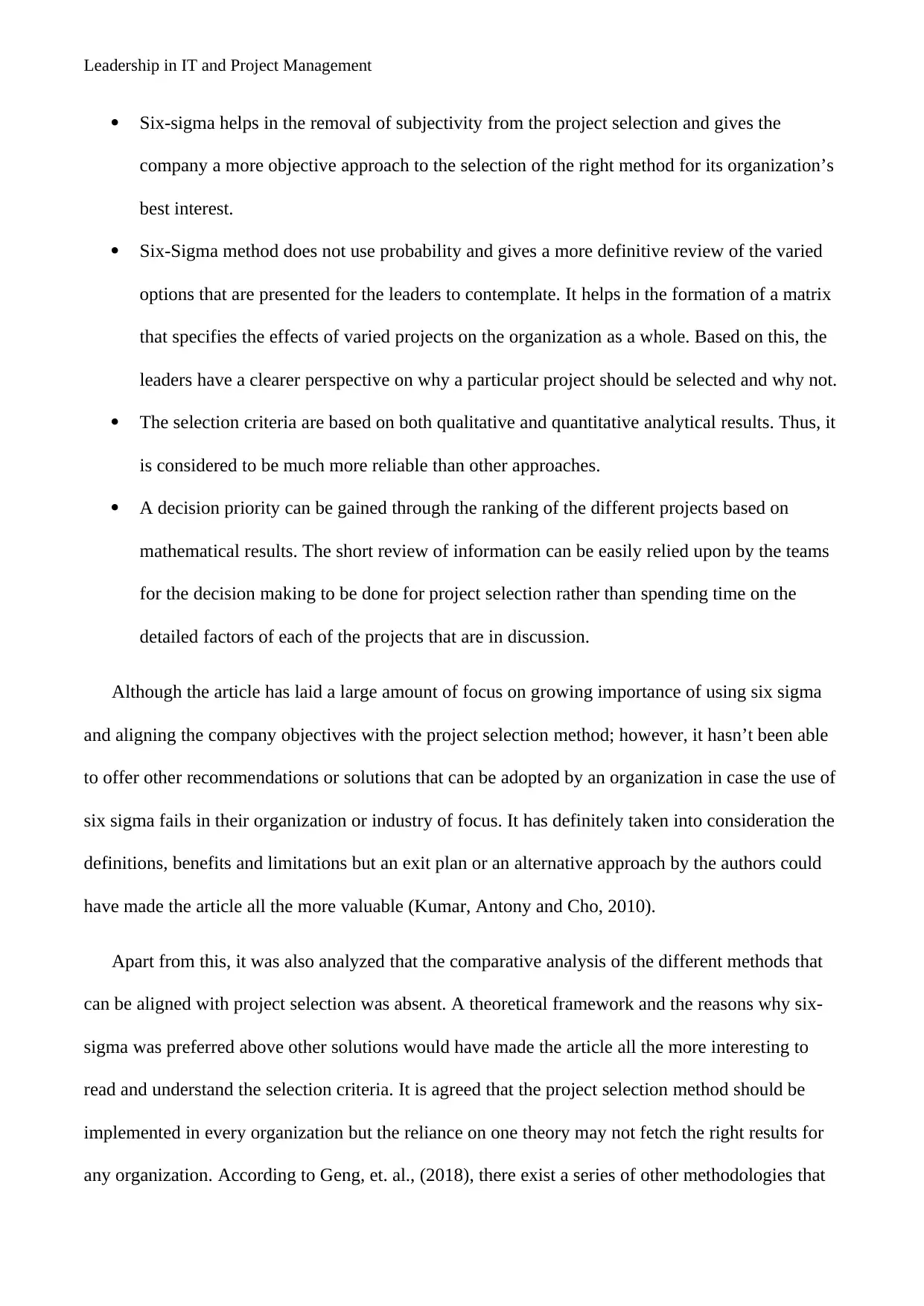
Leadership in IT and Project Management
Six-sigma helps in the removal of subjectivity from the project selection and gives the
company a more objective approach to the selection of the right method for its organization’s
best interest.
Six-Sigma method does not use probability and gives a more definitive review of the varied
options that are presented for the leaders to contemplate. It helps in the formation of a matrix
that specifies the effects of varied projects on the organization as a whole. Based on this, the
leaders have a clearer perspective on why a particular project should be selected and why not.
The selection criteria are based on both qualitative and quantitative analytical results. Thus, it
is considered to be much more reliable than other approaches.
A decision priority can be gained through the ranking of the different projects based on
mathematical results. The short review of information can be easily relied upon by the teams
for the decision making to be done for project selection rather than spending time on the
detailed factors of each of the projects that are in discussion.
Although the article has laid a large amount of focus on growing importance of using six sigma
and aligning the company objectives with the project selection method; however, it hasn’t been able
to offer other recommendations or solutions that can be adopted by an organization in case the use of
six sigma fails in their organization or industry of focus. It has definitely taken into consideration the
definitions, benefits and limitations but an exit plan or an alternative approach by the authors could
have made the article all the more valuable (Kumar, Antony and Cho, 2010).
Apart from this, it was also analyzed that the comparative analysis of the different methods that
can be aligned with project selection was absent. A theoretical framework and the reasons why six-
sigma was preferred above other solutions would have made the article all the more interesting to
read and understand the selection criteria. It is agreed that the project selection method should be
implemented in every organization but the reliance on one theory may not fetch the right results for
any organization. According to Geng, et. al., (2018), there exist a series of other methodologies that
Six-sigma helps in the removal of subjectivity from the project selection and gives the
company a more objective approach to the selection of the right method for its organization’s
best interest.
Six-Sigma method does not use probability and gives a more definitive review of the varied
options that are presented for the leaders to contemplate. It helps in the formation of a matrix
that specifies the effects of varied projects on the organization as a whole. Based on this, the
leaders have a clearer perspective on why a particular project should be selected and why not.
The selection criteria are based on both qualitative and quantitative analytical results. Thus, it
is considered to be much more reliable than other approaches.
A decision priority can be gained through the ranking of the different projects based on
mathematical results. The short review of information can be easily relied upon by the teams
for the decision making to be done for project selection rather than spending time on the
detailed factors of each of the projects that are in discussion.
Although the article has laid a large amount of focus on growing importance of using six sigma
and aligning the company objectives with the project selection method; however, it hasn’t been able
to offer other recommendations or solutions that can be adopted by an organization in case the use of
six sigma fails in their organization or industry of focus. It has definitely taken into consideration the
definitions, benefits and limitations but an exit plan or an alternative approach by the authors could
have made the article all the more valuable (Kumar, Antony and Cho, 2010).
Apart from this, it was also analyzed that the comparative analysis of the different methods that
can be aligned with project selection was absent. A theoretical framework and the reasons why six-
sigma was preferred above other solutions would have made the article all the more interesting to
read and understand the selection criteria. It is agreed that the project selection method should be
implemented in every organization but the reliance on one theory may not fetch the right results for
any organization. According to Geng, et. al., (2018), there exist a series of other methodologies that
⊘ This is a preview!⊘
Do you want full access?
Subscribe today to unlock all pages.

Trusted by 1+ million students worldwide
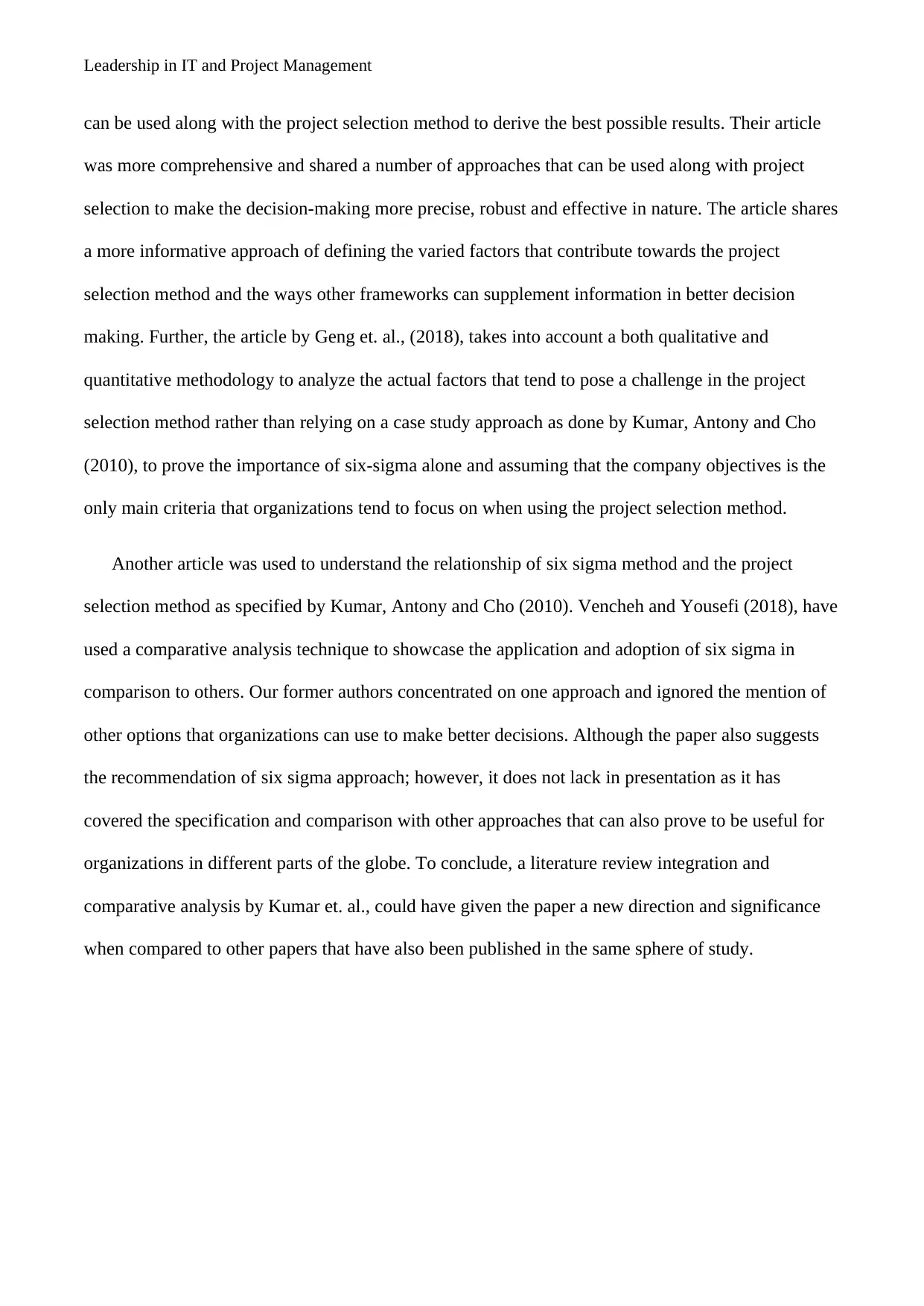
Leadership in IT and Project Management
can be used along with the project selection method to derive the best possible results. Their article
was more comprehensive and shared a number of approaches that can be used along with project
selection to make the decision-making more precise, robust and effective in nature. The article shares
a more informative approach of defining the varied factors that contribute towards the project
selection method and the ways other frameworks can supplement information in better decision
making. Further, the article by Geng et. al., (2018), takes into account a both qualitative and
quantitative methodology to analyze the actual factors that tend to pose a challenge in the project
selection method rather than relying on a case study approach as done by Kumar, Antony and Cho
(2010), to prove the importance of six-sigma alone and assuming that the company objectives is the
only main criteria that organizations tend to focus on when using the project selection method.
Another article was used to understand the relationship of six sigma method and the project
selection method as specified by Kumar, Antony and Cho (2010). Vencheh and Yousefi (2018), have
used a comparative analysis technique to showcase the application and adoption of six sigma in
comparison to others. Our former authors concentrated on one approach and ignored the mention of
other options that organizations can use to make better decisions. Although the paper also suggests
the recommendation of six sigma approach; however, it does not lack in presentation as it has
covered the specification and comparison with other approaches that can also prove to be useful for
organizations in different parts of the globe. To conclude, a literature review integration and
comparative analysis by Kumar et. al., could have given the paper a new direction and significance
when compared to other papers that have also been published in the same sphere of study.
can be used along with the project selection method to derive the best possible results. Their article
was more comprehensive and shared a number of approaches that can be used along with project
selection to make the decision-making more precise, robust and effective in nature. The article shares
a more informative approach of defining the varied factors that contribute towards the project
selection method and the ways other frameworks can supplement information in better decision
making. Further, the article by Geng et. al., (2018), takes into account a both qualitative and
quantitative methodology to analyze the actual factors that tend to pose a challenge in the project
selection method rather than relying on a case study approach as done by Kumar, Antony and Cho
(2010), to prove the importance of six-sigma alone and assuming that the company objectives is the
only main criteria that organizations tend to focus on when using the project selection method.
Another article was used to understand the relationship of six sigma method and the project
selection method as specified by Kumar, Antony and Cho (2010). Vencheh and Yousefi (2018), have
used a comparative analysis technique to showcase the application and adoption of six sigma in
comparison to others. Our former authors concentrated on one approach and ignored the mention of
other options that organizations can use to make better decisions. Although the paper also suggests
the recommendation of six sigma approach; however, it does not lack in presentation as it has
covered the specification and comparison with other approaches that can also prove to be useful for
organizations in different parts of the globe. To conclude, a literature review integration and
comparative analysis by Kumar et. al., could have given the paper a new direction and significance
when compared to other papers that have also been published in the same sphere of study.
Paraphrase This Document
Need a fresh take? Get an instant paraphrase of this document with our AI Paraphraser
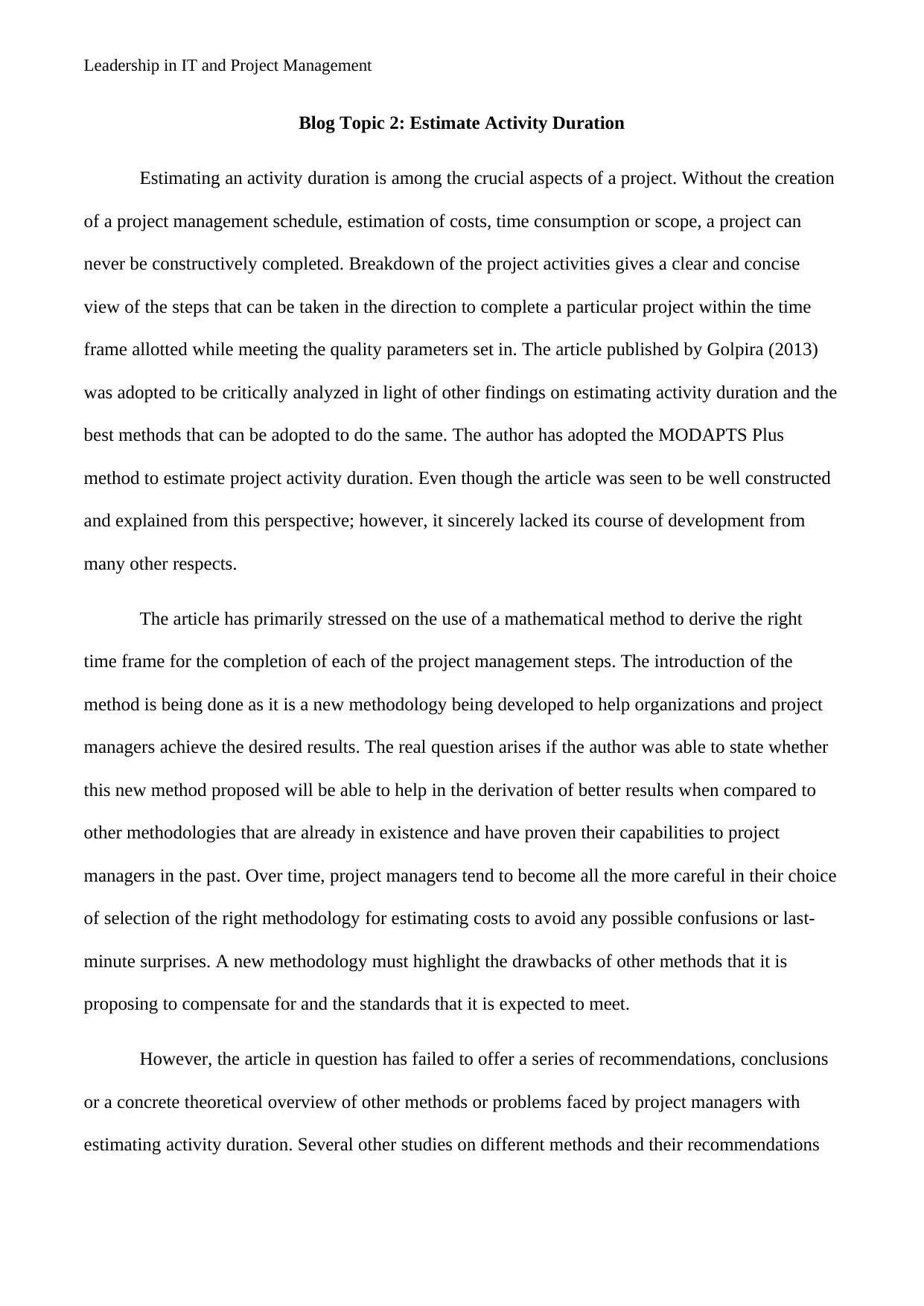
Leadership in IT and Project Management
Blog Topic 2: Estimate Activity Duration
Estimating an activity duration is among the crucial aspects of a project. Without the creation
of a project management schedule, estimation of costs, time consumption or scope, a project can
never be constructively completed. Breakdown of the project activities gives a clear and concise
view of the steps that can be taken in the direction to complete a particular project within the time
frame allotted while meeting the quality parameters set in. The article published by Golpira (2013)
was adopted to be critically analyzed in light of other findings on estimating activity duration and the
best methods that can be adopted to do the same. The author has adopted the MODAPTS Plus
method to estimate project activity duration. Even though the article was seen to be well constructed
and explained from this perspective; however, it sincerely lacked its course of development from
many other respects.
The article has primarily stressed on the use of a mathematical method to derive the right
time frame for the completion of each of the project management steps. The introduction of the
method is being done as it is a new methodology being developed to help organizations and project
managers achieve the desired results. The real question arises if the author was able to state whether
this new method proposed will be able to help in the derivation of better results when compared to
other methodologies that are already in existence and have proven their capabilities to project
managers in the past. Over time, project managers tend to become all the more careful in their choice
of selection of the right methodology for estimating costs to avoid any possible confusions or last-
minute surprises. A new methodology must highlight the drawbacks of other methods that it is
proposing to compensate for and the standards that it is expected to meet.
However, the article in question has failed to offer a series of recommendations, conclusions
or a concrete theoretical overview of other methods or problems faced by project managers with
estimating activity duration. Several other studies on different methods and their recommendations
Blog Topic 2: Estimate Activity Duration
Estimating an activity duration is among the crucial aspects of a project. Without the creation
of a project management schedule, estimation of costs, time consumption or scope, a project can
never be constructively completed. Breakdown of the project activities gives a clear and concise
view of the steps that can be taken in the direction to complete a particular project within the time
frame allotted while meeting the quality parameters set in. The article published by Golpira (2013)
was adopted to be critically analyzed in light of other findings on estimating activity duration and the
best methods that can be adopted to do the same. The author has adopted the MODAPTS Plus
method to estimate project activity duration. Even though the article was seen to be well constructed
and explained from this perspective; however, it sincerely lacked its course of development from
many other respects.
The article has primarily stressed on the use of a mathematical method to derive the right
time frame for the completion of each of the project management steps. The introduction of the
method is being done as it is a new methodology being developed to help organizations and project
managers achieve the desired results. The real question arises if the author was able to state whether
this new method proposed will be able to help in the derivation of better results when compared to
other methodologies that are already in existence and have proven their capabilities to project
managers in the past. Over time, project managers tend to become all the more careful in their choice
of selection of the right methodology for estimating costs to avoid any possible confusions or last-
minute surprises. A new methodology must highlight the drawbacks of other methods that it is
proposing to compensate for and the standards that it is expected to meet.
However, the article in question has failed to offer a series of recommendations, conclusions
or a concrete theoretical overview of other methods or problems faced by project managers with
estimating activity duration. Several other studies on different methods and their recommendations
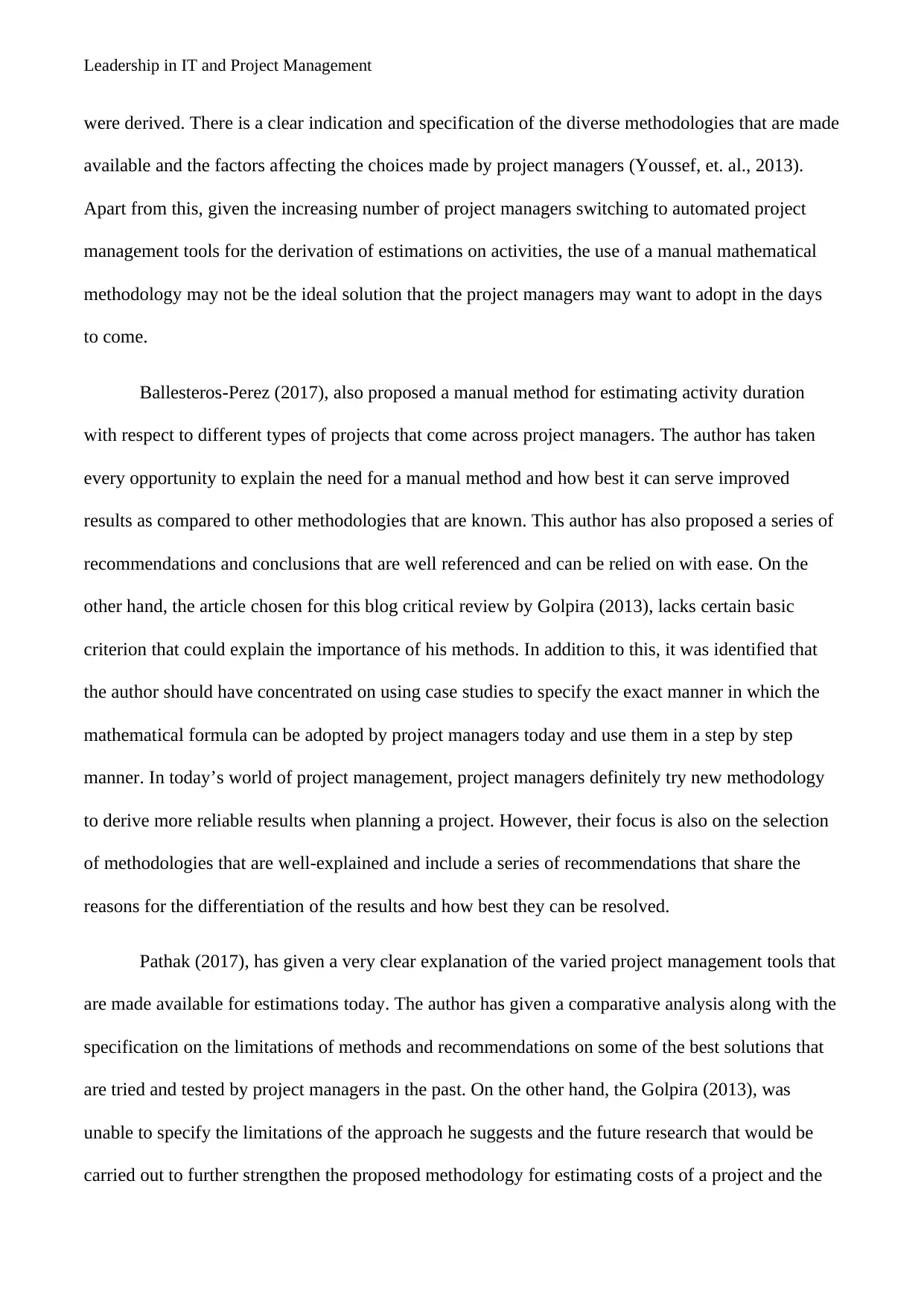
Leadership in IT and Project Management
were derived. There is a clear indication and specification of the diverse methodologies that are made
available and the factors affecting the choices made by project managers (Youssef, et. al., 2013).
Apart from this, given the increasing number of project managers switching to automated project
management tools for the derivation of estimations on activities, the use of a manual mathematical
methodology may not be the ideal solution that the project managers may want to adopt in the days
to come.
Ballesteros-Perez (2017), also proposed a manual method for estimating activity duration
with respect to different types of projects that come across project managers. The author has taken
every opportunity to explain the need for a manual method and how best it can serve improved
results as compared to other methodologies that are known. This author has also proposed a series of
recommendations and conclusions that are well referenced and can be relied on with ease. On the
other hand, the article chosen for this blog critical review by Golpira (2013), lacks certain basic
criterion that could explain the importance of his methods. In addition to this, it was identified that
the author should have concentrated on using case studies to specify the exact manner in which the
mathematical formula can be adopted by project managers today and use them in a step by step
manner. In today’s world of project management, project managers definitely try new methodology
to derive more reliable results when planning a project. However, their focus is also on the selection
of methodologies that are well-explained and include a series of recommendations that share the
reasons for the differentiation of the results and how best they can be resolved.
Pathak (2017), has given a very clear explanation of the varied project management tools that
are made available for estimations today. The author has given a comparative analysis along with the
specification on the limitations of methods and recommendations on some of the best solutions that
are tried and tested by project managers in the past. On the other hand, the Golpira (2013), was
unable to specify the limitations of the approach he suggests and the future research that would be
carried out to further strengthen the proposed methodology for estimating costs of a project and the
were derived. There is a clear indication and specification of the diverse methodologies that are made
available and the factors affecting the choices made by project managers (Youssef, et. al., 2013).
Apart from this, given the increasing number of project managers switching to automated project
management tools for the derivation of estimations on activities, the use of a manual mathematical
methodology may not be the ideal solution that the project managers may want to adopt in the days
to come.
Ballesteros-Perez (2017), also proposed a manual method for estimating activity duration
with respect to different types of projects that come across project managers. The author has taken
every opportunity to explain the need for a manual method and how best it can serve improved
results as compared to other methodologies that are known. This author has also proposed a series of
recommendations and conclusions that are well referenced and can be relied on with ease. On the
other hand, the article chosen for this blog critical review by Golpira (2013), lacks certain basic
criterion that could explain the importance of his methods. In addition to this, it was identified that
the author should have concentrated on using case studies to specify the exact manner in which the
mathematical formula can be adopted by project managers today and use them in a step by step
manner. In today’s world of project management, project managers definitely try new methodology
to derive more reliable results when planning a project. However, their focus is also on the selection
of methodologies that are well-explained and include a series of recommendations that share the
reasons for the differentiation of the results and how best they can be resolved.
Pathak (2017), has given a very clear explanation of the varied project management tools that
are made available for estimations today. The author has given a comparative analysis along with the
specification on the limitations of methods and recommendations on some of the best solutions that
are tried and tested by project managers in the past. On the other hand, the Golpira (2013), was
unable to specify the limitations of the approach he suggests and the future research that would be
carried out to further strengthen the proposed methodology for estimating costs of a project and the
⊘ This is a preview!⊘
Do you want full access?
Subscribe today to unlock all pages.

Trusted by 1+ million students worldwide
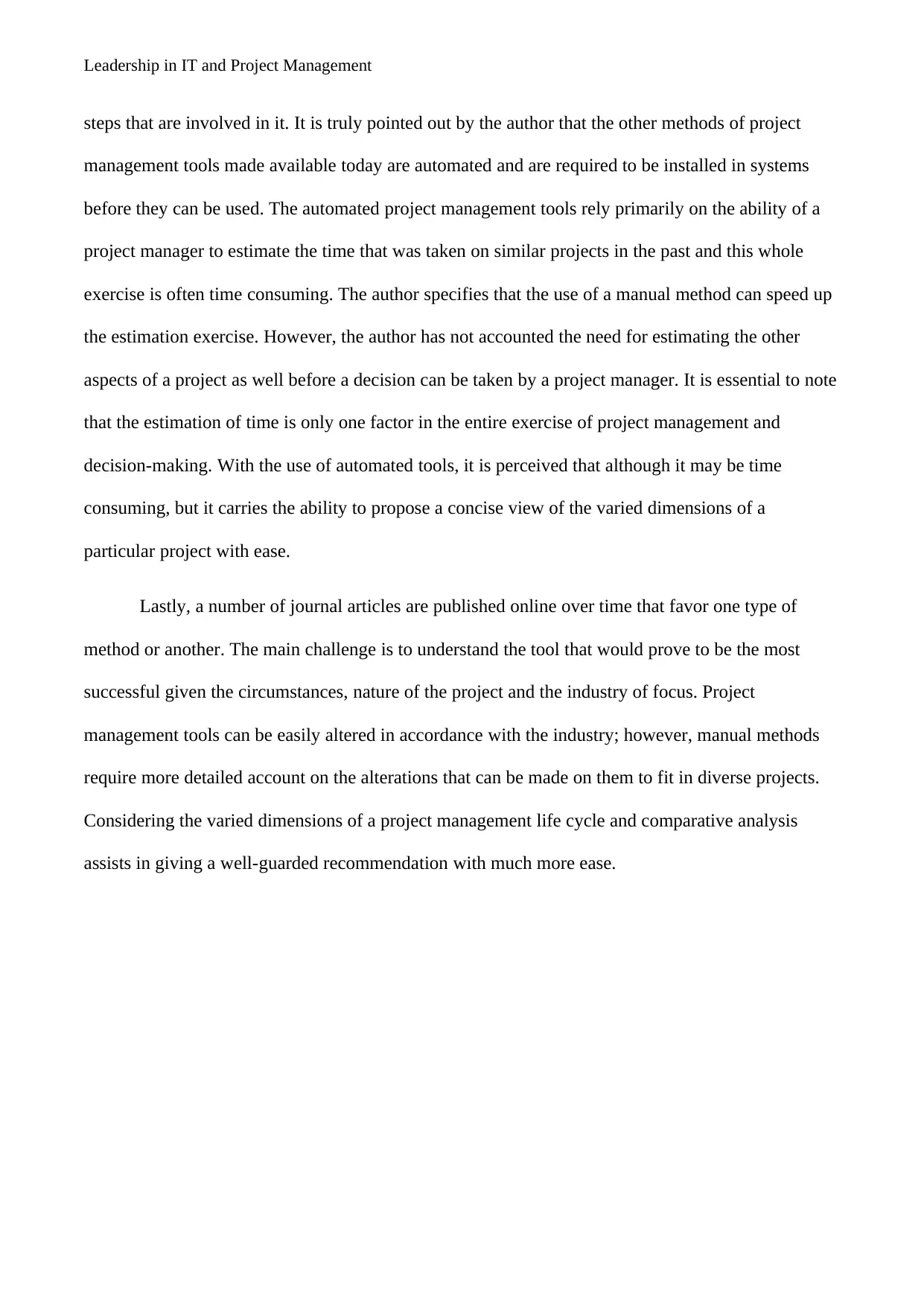
Leadership in IT and Project Management
steps that are involved in it. It is truly pointed out by the author that the other methods of project
management tools made available today are automated and are required to be installed in systems
before they can be used. The automated project management tools rely primarily on the ability of a
project manager to estimate the time that was taken on similar projects in the past and this whole
exercise is often time consuming. The author specifies that the use of a manual method can speed up
the estimation exercise. However, the author has not accounted the need for estimating the other
aspects of a project as well before a decision can be taken by a project manager. It is essential to note
that the estimation of time is only one factor in the entire exercise of project management and
decision-making. With the use of automated tools, it is perceived that although it may be time
consuming, but it carries the ability to propose a concise view of the varied dimensions of a
particular project with ease.
Lastly, a number of journal articles are published online over time that favor one type of
method or another. The main challenge is to understand the tool that would prove to be the most
successful given the circumstances, nature of the project and the industry of focus. Project
management tools can be easily altered in accordance with the industry; however, manual methods
require more detailed account on the alterations that can be made on them to fit in diverse projects.
Considering the varied dimensions of a project management life cycle and comparative analysis
assists in giving a well-guarded recommendation with much more ease.
steps that are involved in it. It is truly pointed out by the author that the other methods of project
management tools made available today are automated and are required to be installed in systems
before they can be used. The automated project management tools rely primarily on the ability of a
project manager to estimate the time that was taken on similar projects in the past and this whole
exercise is often time consuming. The author specifies that the use of a manual method can speed up
the estimation exercise. However, the author has not accounted the need for estimating the other
aspects of a project as well before a decision can be taken by a project manager. It is essential to note
that the estimation of time is only one factor in the entire exercise of project management and
decision-making. With the use of automated tools, it is perceived that although it may be time
consuming, but it carries the ability to propose a concise view of the varied dimensions of a
particular project with ease.
Lastly, a number of journal articles are published online over time that favor one type of
method or another. The main challenge is to understand the tool that would prove to be the most
successful given the circumstances, nature of the project and the industry of focus. Project
management tools can be easily altered in accordance with the industry; however, manual methods
require more detailed account on the alterations that can be made on them to fit in diverse projects.
Considering the varied dimensions of a project management life cycle and comparative analysis
assists in giving a well-guarded recommendation with much more ease.
Paraphrase This Document
Need a fresh take? Get an instant paraphrase of this document with our AI Paraphraser
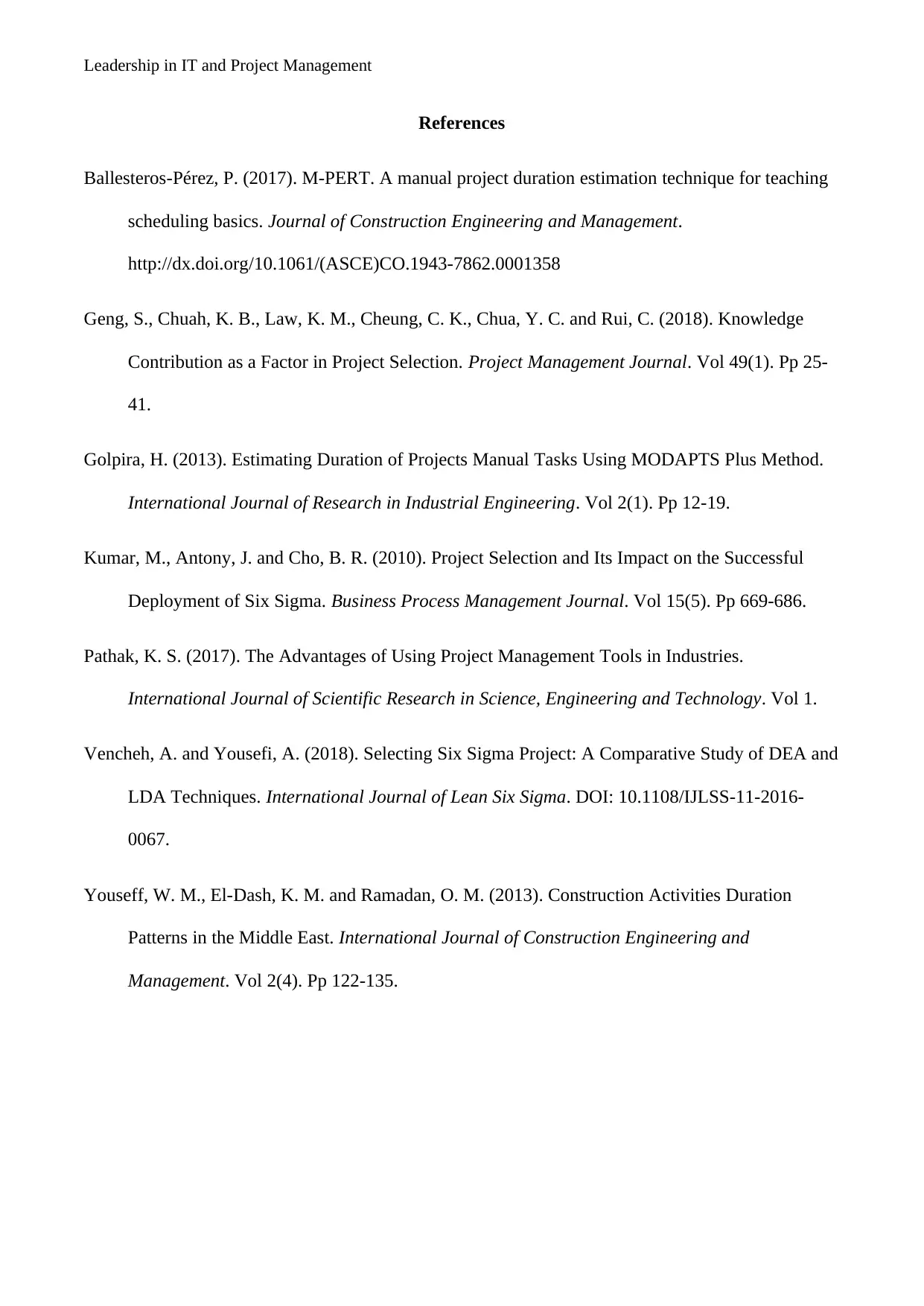
Leadership in IT and Project Management
References
Ballesteros-Pérez, P. (2017). M-PERT. A manual project duration estimation technique for teaching
scheduling basics. Journal of Construction Engineering and Management.
http://dx.doi.org/10.1061/(ASCE)CO.1943-7862.0001358
Geng, S., Chuah, K. B., Law, K. M., Cheung, C. K., Chua, Y. C. and Rui, C. (2018). Knowledge
Contribution as a Factor in Project Selection. Project Management Journal. Vol 49(1). Pp 25-
41.
Golpira, H. (2013). Estimating Duration of Projects Manual Tasks Using MODAPTS Plus Method.
International Journal of Research in Industrial Engineering. Vol 2(1). Pp 12-19.
Kumar, M., Antony, J. and Cho, B. R. (2010). Project Selection and Its Impact on the Successful
Deployment of Six Sigma. Business Process Management Journal. Vol 15(5). Pp 669-686.
Pathak, K. S. (2017). The Advantages of Using Project Management Tools in Industries.
International Journal of Scientific Research in Science, Engineering and Technology. Vol 1.
Vencheh, A. and Yousefi, A. (2018). Selecting Six Sigma Project: A Comparative Study of DEA and
LDA Techniques. International Journal of Lean Six Sigma. DOI: 10.1108/IJLSS-11-2016-
0067.
Youseff, W. M., El-Dash, K. M. and Ramadan, O. M. (2013). Construction Activities Duration
Patterns in the Middle East. International Journal of Construction Engineering and
Management. Vol 2(4). Pp 122-135.
References
Ballesteros-Pérez, P. (2017). M-PERT. A manual project duration estimation technique for teaching
scheduling basics. Journal of Construction Engineering and Management.
http://dx.doi.org/10.1061/(ASCE)CO.1943-7862.0001358
Geng, S., Chuah, K. B., Law, K. M., Cheung, C. K., Chua, Y. C. and Rui, C. (2018). Knowledge
Contribution as a Factor in Project Selection. Project Management Journal. Vol 49(1). Pp 25-
41.
Golpira, H. (2013). Estimating Duration of Projects Manual Tasks Using MODAPTS Plus Method.
International Journal of Research in Industrial Engineering. Vol 2(1). Pp 12-19.
Kumar, M., Antony, J. and Cho, B. R. (2010). Project Selection and Its Impact on the Successful
Deployment of Six Sigma. Business Process Management Journal. Vol 15(5). Pp 669-686.
Pathak, K. S. (2017). The Advantages of Using Project Management Tools in Industries.
International Journal of Scientific Research in Science, Engineering and Technology. Vol 1.
Vencheh, A. and Yousefi, A. (2018). Selecting Six Sigma Project: A Comparative Study of DEA and
LDA Techniques. International Journal of Lean Six Sigma. DOI: 10.1108/IJLSS-11-2016-
0067.
Youseff, W. M., El-Dash, K. M. and Ramadan, O. M. (2013). Construction Activities Duration
Patterns in the Middle East. International Journal of Construction Engineering and
Management. Vol 2(4). Pp 122-135.
1 out of 8
Related Documents
Your All-in-One AI-Powered Toolkit for Academic Success.
+13062052269
info@desklib.com
Available 24*7 on WhatsApp / Email
![[object Object]](/_next/static/media/star-bottom.7253800d.svg)
Unlock your academic potential
Copyright © 2020–2025 A2Z Services. All Rights Reserved. Developed and managed by ZUCOL.



